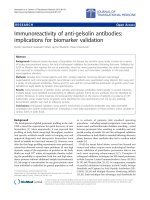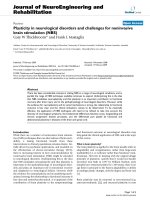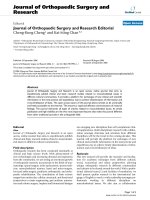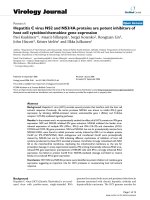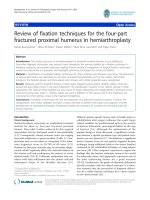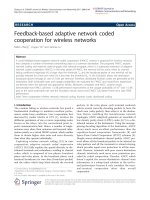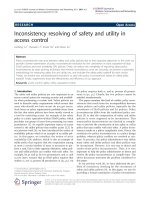Báo cáo hóa học: "Editorial Advanced Communication Techniques and Applications for High-Altitude Platforms" pot
Bạn đang xem bản rút gọn của tài liệu. Xem và tải ngay bản đầy đủ của tài liệu tại đây (433.69 KB, 3 trang )
Hindawi Publishing Corporation
EURASIP Journal on Wireless Communications and Networking
Volume 2008, Article ID 934837, 3 pages
doi:10.1155/2008/934837
Editorial
Advanced Communication Techniques and Applications for
High-Altitude Platforms
Abbas Mohammed,
1
Shlomi Arnon,
2
David Grace,
3
Marina Mondin,
4
and Ryu Miura
5
1
Department of Sig nal Processing, Blekinge Institute of Technology, 372 25 Ronneby, Sweden
2
Department of Electrical and Computer Engineering, Ben-Gurion University of the Negev, 84105 Beer-Shiva, Israel
3
Department of Electronics, The University of York, York YO10 5DD, UK
4
Dipartimento di Elettronica, Politecnico di Torino, 10129 Torino, Italy
5
Adaptive Communications Research laboratories, Advanced Telecommunications Research Institute International (ATR),
Kyoto 619-0288, Japan
Correspondence should be addressed to Abbas Mohammed,
Received 20 November 2008; Accepted 20 November 2008
Copyright © 2008 Abbas Mohammed et al. This is an open access article distributed under the Creative Commons Attribution
License, which permits unrestricted use, dist ribution, and reproduction in any medium, provided the original work is properly
cited.
We are beginning to witness an exciting era for researchers
and developers of advanced future generation multimedia
telecommunication systems. High-altitude platform (HAP)
systems are among these novel technologies and are star ting
to attract considerable attention worldwide. Research and
development activities include the EU FP6 CAPANINA
Project and the COST 297 Action in Europe, along with
government-funded projects in Japan, Korea, and USA.
Commercial projects are also underway in Switzerland, USA,
China, and UK.
High-altitude platforms (HAPs) are airships or planes,
operating in the stratosphere, at altitudes of typically 17–
22 km (around 75000 ft). At this a ltitude (which is well above
commercial aircraft height), they can maintain a quasi-
stationary position and support payloads to deliver a range
of services: principally communications, and remote sensing.
Communications services including broadband, WiMAX,
3G, and emergency communications, as well as broadcast
services, are under consideration. A recent HAP trial in
Sweden has successfully tested the usage of a HAP at 24 km
altitude, operating in the mm-wave band to send data via Wi-
Fi (802.11b) to a coverage area of 60 km in diameter, with the
goal of demonstrating the potential of this novel technology.
A HAP can provide the best features of both terrestrial
masts (which may be subject to planning restrictions and/or
related environmental/health constraints) and satellite sys-
tems (which are usually highly expensive). This makes HAP
a viable competitor/complement to conventional terrestrial
infrastructures and satellite systems. In particular, HAPs
permit rapid deployment, and highly efficient use of the
radio spectrum (largely through intensive frequency reuse).
The relatively close r ange of HAPs compared to satellites
means that data rates can be sig nificantly higher for the
same size antennas, and imaging and remote sensing are
highly effective, offering low cost and high resolution. A
variety of hybrid applications may also be envisaged, such
as traffic management, navigation, security management,
and so on. There are two fundamental types of platform
technology capable of stratospheric flight: manned and
unmanned aircraft, and unmanned airships. Other platform
technologies at lower altitudes, including manned aircraft
and tethered aerostats, and Unmanned Aerial Vehicles
(UAVs) may also play a developmental role towards HAPs
and their applications.
HAPs differ from other means of communications
delivery in the fact that HAP movement and limited
mission durations must be taken into consideration in
order to ensure that communication services are maintained.
Innovative solutions including mechatronic antenna beam
steering techniques, smart and MIMO antenna technologies,
intra/inter HAP handoff processes, and diversity techniques
could play an important role. Multiple bearer systems,
using multiband wireless and free space optic technologies,
including hybrid terminals can exploit the advantageous
propagation environment. Integrated networks containing
HAP, terrestrial, and satellite components can be further used
to enhance the user exper ience and exploit the best features
of each segment.
2 EURASIP Journal on Wireless Communications and Networking
In light of the above, it was therefore timely to propose a
special issue exploring recent advances in communications
and applications linked to HAPs and related systems. The
main purposes of this special issue are three-fold:
(i) highlighting the recently emerged technological
advances, new tr ials, and applications related to
HAPs,
(ii) reporting on the ac tivities of the European COST 297
Action,
(iii) promoting these novel results to a wider audience.
After a stringent peer-review procedure by experts in the
field, thirteen papers were accepted for inclusion in this
special issue. The papers cover different aspects of HAP
systems and are grouped in the following four categories.
The first category provides an overview of HAPs for
disaster recovery and emergency telecommunications (the
first paper). The second category addresses the coexistence
scenarios and interference management (from the second to
the sixth paper). The third category covers the propagation
effects, trials and demonstrations for HAP systems (from
the seventh to the twelfth paper). Finally, the for t h category
which addresses the techno-economic issues of HAP-based
communications is covered by the last paper.
The first paper, “High-altitude platforms for disaster
recovery: capabilities, strategies, and techniques for emer-
gency telecommunications,” by J. Deaton, presents a very
well-reasoned case for using HAPs to provide emergency
communications infrastructure following a major disaster.
Interesting case studies of past disasters are discussed, for
example, New Orleans after Hurricane Katrina. The author
shows how HAPs can be used to implement critical elements
of a cellular communications system to give the emergency
services an access to multiple applications and services in the
immediate aftermath of a disaster. The pros and cons of the
different architectural configurations of the communications
architecture are discussed.
In the second paper, “Downlink coexistence performance
assessment and techniques for WiMAX services from high-
altitude platform and terrestrial deployments,” by Z. Yang et
al., the authors investigate the performance and coexistence
techniques for worldwide interoperability for microwave
access (WiMAX) delivered from high-altitude platforms
(HAPs) and terrestrial systems in shared 3.5 GHz frequency
bands. The paper shows that it is possible to provide WiMAX
services from individual HAPs systems.
In the third paper, “Performance evaluation of WiMAX
broadband from high-altitude platform cellular system and
terrestrial coexistence capability,” by Z. Yang et al., the
performance of a WiMAX microwave access link from
HAP is investigated, and the coexistence capability w ith
multiple-operator terrestrial WiMAX deployments in the
same frequency band is examined. The HAP coverage area
is divided into multiple cells served by a multi-antenna
payload, and both uplink and downlink performances are
analyzed.
The forth paper “Coexistence performance of high-
altitude platform and terrestrial system using gigabit com-
munication links to serve specialist users,” by Z. Peng and
D. Grace, proposes some iterative methods to adjust the
pointing direction of aperture antenna in mm-wave bands
onboard HAP for the purpose of providing the highest
CINR value at specialist users. The system scenario assumes
that the specialist user needs a very high speed link up
to 3 Gbps for the transmission of uncompressed HDTV
pre-broadcast content, sharing the same frequency band
with point-to-point terrestrial link. The methods become
important particularly when the HAP covers a wide service
area like 300 km in diameter.
The fifth paper “WCDMA uplink interference assessment
from multiple hig h-altitude platform configurations,” by
T. Hult et al., investigates the possibility of multiple HAP
coverage of a common cell area using a WCDMA system,
focusing on the analysis of the uplink system performance.
In the sixth paper “An evaluation of interference miti-
gation schemes for HAP systems,” by B-J. Ku et al., various
performance evaluation results of interference mitigation
schemes from HAPS user terminals (HUTs) are presented.
The results include performance evaluations using a new
interference mitigation approach as well as conventional
approaches. An adaptive beamforming scheme (ABS) is
introduced as a new scheme for efficient frequency sharing,
and the interference mitigation effect on the ABS is examined
considering pointing mismatch errors. The authors show
that the application of ABS enables frequency sharing
between two systems with a smaller power reduction of
HUTs in a co-coverage area compared to conventional
schemes.
The seventh paper “Penetration loss measurement and
modeling for HAP mobile systems in urban environment,”
by J. Holis and P. Pechac, presents the results of a building
penetration loss measurement campaign performed using a
remote-controlled airship, and proposes an empirical model
for predicting penetration loss in 3G and 4G HAP-based
mobile systems.
In the eighth paper, “Building entry loss and delay spread
measurements on a simulated HAP-to-indoor link at S-
band,” by F. Perez-Fontan et al., the results of a measurement
campaign emulating the high-altitude platform (HAP)-to-
indoor communication channel at S-band are presented.
A link was established between a transmitter, carried by a
helicopter representing the HAP, and a receiver placed at
several locations in different building types. A wideband,
directive channel sounder was used to measure building
entry loss and time delay spread. Results of the building entry
loss are presented as a function of building type, elevation,
and building entry angle. Results of delay spread for each
building are also provided.
The ninth paper “A WiMAX payload for high-altitude
platform experiment trials,” by J. Thornton et al., reports
the communication system design and results of terrestrial
and airborne pretrials for WiMAX payload developed for the
Swiss-based HAP programme “StratXX”. The terrestrial trial
took place to evaluate long-distance LOS performance. The
airborne trial that used a helicopter at a low altitude shows
Abbas Mohammed et al. 3
the potential for WiMAX service from aerial platform. This
paper is valuable as a report of field trial on HAP, the number
of which is very limited to date.
The tenth paper “A study of gas and rain propagation
effects at 48 GHz for HAP Scenarios,” by S. Zvanovec et
al., assesses the effects of atmosphere and rainfall on HAP
millimeter-wave links through measurements and simula-
tion of these phenomena. The gas attenuation measurements
are performed using a Fabry-Perot resonator-based system,
while the rain attenuation is analyzed considering both single
and double HAP link scenarios.
In the eleventh paper “Posthumous numerical study of
DTV broadcast antenna integration with prototype strato-
spheric airship gondola,” by D. Gray et al., the 2004 digital
television (DTV) broadcast demonstration using a prototype
stratospheric airship is reviewed. The authors found out
that random signal loss is experienced at the receiving
station directly below the airship, and later they identified a
possible cause of this signal loss. Several possible mitigation
techniques and alternative antenna designs which would
have fitted within the constraints of the 2004 demonstration
were then compared.
The twelfth paper “Application of single-mode fiber-
coupled receivers in optical satellite to high-altitude platform
communications,” by F. Fidler and O. Wallner, investigates
the phase f ront distortions induced by atmospheric turbu-
lence on the efficiency with which the laser beam is coupled
into a single-mode fiber. The authors analyzed different
link scenarios including a geostationary satellite (GEO), a
high-altitude platform (HAP), and an optical ground station
(OGS).
Finally, the last paper “Is HAPS viable for the next
generation telecommunication platform in korea?,” by J. Kim
et al., presents a techno-economic analysis of the delivery
of the 3G telecommunications systems taking into account
HAP capacity, and speed of migration from existing means of
delivery. This is one of the first papers to consider the techno-
economic issues of HAP-based communications, a subject
that is of critical importance for operators, entrepreneurs,
and investors when considering the future of this technology.
ACKNOWLEDGMENTS
The guest editors would like to thank the authors for their
contributions and the reviewers who dedicated their pre-
cious time in providing numerous comments, suggestions,
and corrections that helped improve the quality of the
manuscripts. We would also like to thank the past and
present Editors-in-Chief Phil Regalia and Luc Vandendrope
for the interest in this special issue and for giving us the
opportunity to publish in this journal, and the editorial
staff from Hindawi Publishing Corporation for their support
throughout the editing process. We acknowledge the contri-
bution of the COST research programme of the European
Science Foundation. Indeed, the first four guest editors are
members of the European COST 297 Action “HAPCOS—
High-Altitude Platforms for Communications and Other
Services,” and the fifth guest editor is an Associate Member
of this action. In addition, eight pap ers in this special issue
were authored by various members of this action. COST 297
commenced in September 2005 for a period of 4 years, and
is the largest gathering of research community with interest
in HAPs and related systems. The guest editors believe that
this special issue will be of great value to the academic and
industrial research community and standardization bodies.
Finally, we hope that the readers will find the papers in this
special issue helpful to their research and future development
in this innovative technology.
Abbas Mohammed
Shlomi Arnon
David Grace
Marina Mondin
Ryu Miura
